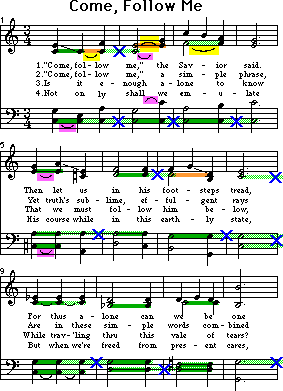In Context
In modern notation, THE BAR LINE always precedes the first and strongest beat. Normally, avoid anything that would weaken the first beat, such as tying into it from the preceding measure. (See the blue “X” spots.)
There is one common exception: usually you should tie the soprano into the alto when soprano ascends and alto is where the soprano had been (see measure 1 & 2, yellow highlights), even if the two notes straddle a bar line. For an example of this, see the soprano/alto common tones on both sides of the bar line between measures 12 and 13 of this hymn.
Since beat 1 is always stronger than beat 2 and beat 1 is usually stronger than 3, tying repeated notes that occur from beat 1 to 2 or from 1 to 3 may be effective (see purple highlights).
Beats 2 and 3 in a three-beat measure are both weak, but 3 is stronger than 2. Tying from beat 2 to 3 may be advisable (see measure 3). However, since this adds to the strength of beat 2, be sure that it does not overpower beat 1 (especially) or 3, which would result in a sort of “syncopated effect” or false accent.
Index